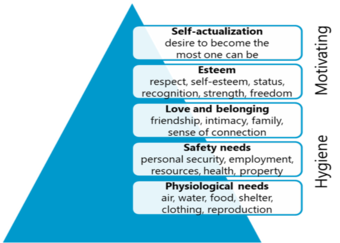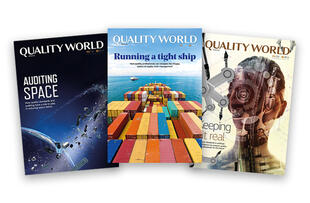
Human factors in manufacturing – Part 2
Progress indicator

In the second part of this two part series, David Scrimshire explores how to better address the root causes for human errors and how to motivate people in your organisation
Influencing operator motivation – practical psychology
Clearly it is far preferable to avoid human error happening, as a result of one or more human factors, in the first place. Systematic use of one or more of the models explained in the first part of this article (Ishikawa diagram, Why Tree, the therefore test, FMEA and the Bow Tie model) will determine these root causes, so that robust ‘controls’ may be put in place.
Nevertheless, we are dealing with human beings, who are subject to human factors, which could lead to human errors and their negative consequences. What we want is highly motivated operators who will adhere to the robust planned arrangements now deployed to guarantee right-first-time performance.
The problem is how to motivate? – this is where Maslow (Abraham Harold Maslow was an American psychologist who was best known for creating Maslow's hierarchy of needs) and Herzberg (Frederick Irving Herzberg was an American psychologist who became one of the most influential names in business management) come in (see Figure 6).

Figure 6
Maslow's hierarchy of needs comprises a five-tier model of human needs, often depicted as hierarchical levels within a pyramid. Needs lower down in the hierarchy must be satisfied before individuals can attend to needs higher up. From the bottom of the hierarchy upwards, the needs are: physiological, safety, love and belonging, esteem and self-actualisation.
Herzberg built on Maslow's theory and showed that individuals are not content with the satisfaction of the three lower-order needs at work. For example, those needs associated with minimum salary levels or safe and pleasant working conditions are viewed as ‘givens’. Rather, individuals look for the gratification of the two higher-level psychological needs relating to achievement, recognition, responsibility, advancement, and the nature of the work itself.
From Maslow’s hierarchy of needs and the practical work of Herzberg, it is clear that you cannot motivate another person to do anything (it has to come from them) but you can influence them. This is the basis of CBT (cognitive behavioural therapies) which are a range of ‘talking therapies’ based on the theory that thoughts, feelings, behaviour (i.e. what we do) and how our body feels are interconnected. If we change one of these, we can alter the others. Consequently, ‘wrong’ (i.e. negative) thoughts and feelings (i.e. mindset) can directly affect an individual’s perception and trap them in a vicious cycle of incorrect behaviour (i.e. continuing to make human errors in their work).
You don’t have to be a qualified therapist to make cognitive behaviour therapy work in the manufacturing environment, you just need to be convinced that it works and know how to use it effectively. Obviously, thoughts and feelings are internal to the person concerned, and they may not be aware of the activity.
“The flesh is the surface of the unknown” – Victor Hugo
A person’s behaviours (what they do or don’t do) and results (how well they do it) are external (and can typically be observed and measured). So, focus on behaviours and results, and provide operators with on-purpose/situational feedback when things have gone wrong and when things have gone right. In the words of Ken Blanchard (an American author and management expert): “Feedback is the breakfast of champions”. The more feedback you give to people, the better it is, as long as the feedback is objective and not critical.
Once the human factor(s) are determined, the operator must take responsibility and work with their colleagues to design and use effective controls to ensure that the event/hazard is prevented. As a manager, you must recognise that every interaction you have with an operator generates an experience for them.
As Tim Autrey suggests, in his book 6-hour safety culture, you can consciously engage them ‘on-purpose’ in a ‘situational context’ relating to the result of their behaviour – in other words it’s a feedback loop.
A tried-and-tested approach that is proven to work is to focus on TGW (things gone wrong) and TGR (things gone right), and use a modified process based on Ken Blanchard’s (an American author and management expert)“one-minute reprimand/praise” approach.
TGW (things-gone-wrong):
- Tell everyone beforehand that you are going to let them know how they are doing and stress that the organisation will always investigate instances of human error in a systematic manner without the blame culture.
- Involve relevant people immediately when the event/hazard is discovered and include them in the search for the true root cause(s).
- Once the cause(s) are determined, highlight the human factor(s) involved and explain what their contribution was.
- Involve relevant people in the development of alternative actions that can
(i) prevent the event/hazard happening again, or (ii) mitigate the consequences should it happen – focused on the established cause(s). - Select and deploy the most effective solution to permanently fix the identified root cause(s) so that re-occurrences don’t happen/will be detected.
- Let the people know that you are honestly on their side and remind them how much you value them and their input to event/hazard prevention.
TGR (things-gone-right):
- Tell people right from the start that you are going to let them know how they are doing.
- Praise people immediately when you discover a significant incident where the person used their initiative to (i) prevent an error from occurring, or (ii) bring safety-related information to light.
- Tell people what they did right – be specific.
- Tell people how you feel about what they did right (behaviour), and how it helps the organisation, other people who work there, and the customers.
- Stop for a moment of silence to let them ‘feel’ how good you feel.
- Encourage them to do more of the same.
- Shake hands or make the appropriate gesture in a way that makes it clear that you support their success in the organisation.
Remember the saying ‘different strokes for different folks’, so you will need to customise, to an extent, how you provide the feedback to individuals but be consistent. You can influence motivation with on-purpose/situational feedback.
The core principles to boost motivation
As an essential first step to influence motivation, an organisation must establish and maintain a just culture – that is, an atmosphere of trust in which operators are encouraged (even rewarded) for providing essential safety-related information, but in which they are also clear about where the line must be drawn between acceptable and unacceptable behaviour.
Such a climate will naturally cultivate the ethical behaviour in operators in which:
- The fact that the safety and lives of others are dependent upon the skill and judgment of operators is stressed;
- Operators will never undertake work or approve work which is beyond the limits of their authority or knowledge;
- Operators will never pass any product about which they have doubt regarding previous work, inspections or tests.
Consistently operating positive feedback (TGW/TGR) with operators will ensure that they will adopt the following core principles:
- Proactive passion:
- Continuous sustainable drive for improved performance in all things.
- Continuous sustainable drive for improved performance in all things.
- Independent thinking:
- Being responsible for oneself – questioning everything, seeking to understand and innovate.
- Being responsible for oneself – questioning everything, seeking to understand and innovate.
- Honesty:
- Complete transparency and immediately admitting to errors in a no-blame (just culture) atmosphere.
- Complete transparency and immediately admitting to errors in a no-blame (just culture) atmosphere.
- Integrity:
- Always doing the right thing, the right way, for the right reasons.
- Always doing the right thing, the right way, for the right reasons.
- Safety:
- Knowing that the safety and lives of others depend upon one’s own skill and judgment.
- Knowing that the safety and lives of others depend upon one’s own skill and judgment.
- Sanity check:
- A quick test to quickly evaluate whether an action is appropriate.
- A quick test to quickly evaluate whether an action is appropriate.
- KISS (keep it short & simple):
- Make the complex simple, tangible and visual.
Applying the ISO 9001:2015 core concepts to human factors
At the heart of all ISO 9001:2015-based standards (e.g. AS9100:2016 series and IATF 16949) are the three core concepts:
- Risk based thinking
- Process approach
- Plan-do-check-act
These concepts underlie everything we have been discussing in these two articles relating to human errors and their causes – human factors. They are applied in the following manner:
- Risk based thinking
Continue to look for possible human factors that could lead to human errors (hazards) and determine the actual human factors that caused identified human errors (events) – take actions to prevent occurrences/reoccurrences.
- Process approach
Remember the words of Edwards Deming: “If you cannot define what you are doing as a process, you do not understand what you are doing”. Continually strive to remove human factors that lead, or can lead, to human errors by improving the process.
- Plan-do-check-act
Plan: Identify human factors that can cause a situation where human errors can occur – these are precursors or preconditions for hazards/events.
Do: Identify human error-related KPIs (key performance indicators) and their goals – ensure that operators know what these are.
Check: Monitor and measure the human error-related KPIs – provide feedback individually to operators or teams based on bad (TGW) and good (TGR) results against goals, and agree improvement plans whenever necessary.
Act: Take necessary actions to improve performance (zero human errors) and continue to monitor progress going forward. In the words of Edwards Deming: “It is not necessary to change, survival is not mandatory”
In closing, analyse human factors and develop effective controls using the expertise of those with relevant knowledge. The resulting processes (working practices) must be relevant to those who need to know this information – they are your stakeholders. Only by engaging with stakeholders, for example, employees in a particular department, can the human errors be eliminated or, if they do occur, their consequences can be minimised, and future reoccurrences avoided.
About the author: Dr David Scrimshire is Managing Director of TEC Transnational Ltd, a company that specialises in implementing manufacturing and quality systems and train the people who will be operating those systems
Learn more about TEC Transnational Ltd
Quality World

Get the latest news, interviews and features on quality in our industry leading magazine.


